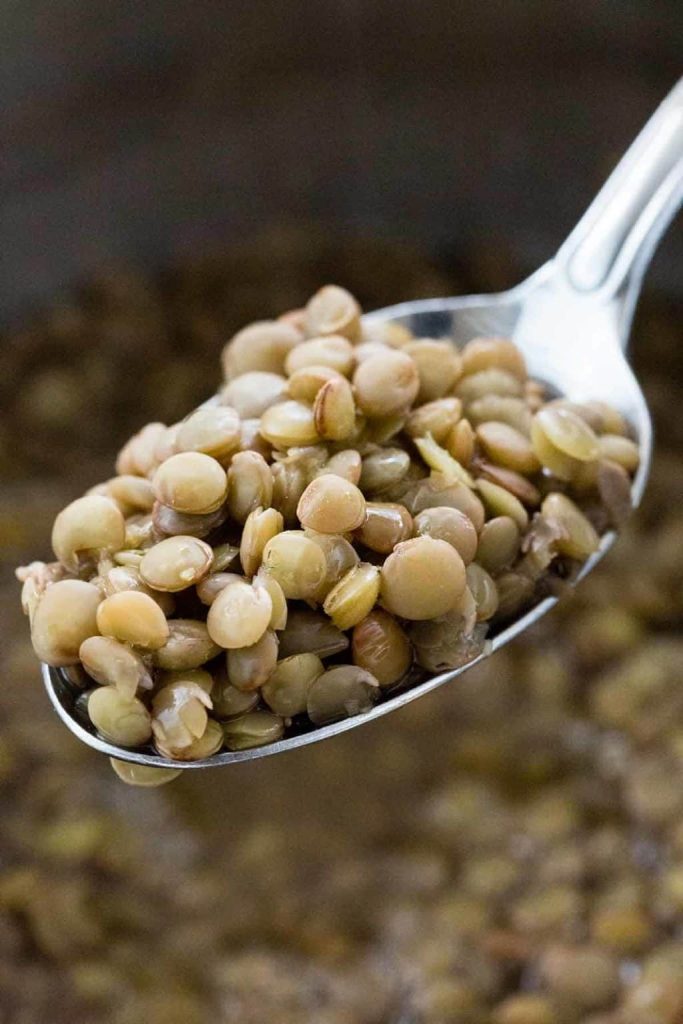
You’ve probably heard lentils are super cool right now – the new quinoa. Wait up, what are they exactly? Lentils are small edible legumes. They are a staple food in many cuisines worldwide, known for their nutritional value, versatility, and affordability. Lentils come in various colors, including brown, green, red, black, and yellow, with each variety having a distinct flavor, texture, and preferred uses.
In culinary applications, lentils can be used in various dishes. They are often included in soups, stews, curries, salads, and side dishes.
Lentils can be cooked to various levels of tenderness, ranging from al dente to soft and creamy, depending on the desired recipe and texture. They absorb flavors well and work harmoniously with spices, herbs, and other ingredients.
Lentils are not only nutritious and versatile but also sustainable. They require less water and fewer resources to grow than animal protein sources, making them an environmentally friendly food choice.
Whether you are a vegetarian, vegan, or simply looking to incorporate more plant-based foods into your diet, lentils are a fantastic ingredient to explore due to their health benefits, culinary flexibility, and accessibility.
Are Lentils Healthy?
Lentils are rich in plant-based protein, dietary fiber, vitamins, minerals, and antioxidants, making them a nutritious addition to a balanced diet. They are low in fat and cholesterol-free, making them a healthy alternative to meat and other animal protein sources. Lentils are also a good source of complex carbohydrates, providing sustained energy.
Types of Lentils
Red: These lentils cook quickly and become mushy, making them perfect for soups, curries, and dals. They have a mild, slightly sweet flavor and a vibrant orange color.
Green: Green lentils are similar to brown lentils but have a slightly peppery flavor and hold their shape even better when cooked. They work well in salads, pilafs, and hearty dishes.
French Lentils (Puy Lentils): These are small and have a dark greenish-blue color. They hold their shape well after cooking and have a robust, earthy flavor. French lentils are ideal for salads, side dishes, and as a bed for proteins.
Black Lentils (Beluga Lentils): Named after their resemblance to caviar, black lentils have a rich, earthy flavor and hold their shape when cooked. They work well in salads, side dishes, and as a striking garnish.
How To Cook Lentils
Preparing Lentils for Cooking
Sort the Lentils: Spread the lentils out on a clean, light-colored surface such as a baking sheet or plate. Pick through them carefully, removing small stones, debris, or damaged lentils. This step helps ensure that you only cook with clean and good-quality lentils.
Rinse the Lentils: Place the sorted lentils in a fine-mesh sieve or colander and hold them under cold running water. Gently stir and agitate the lentils with your fingers while rinsing. The water will help remove any dust, dirt, or residual starch from the lentils.
Repeat the Rinse (Optional): If desired, repeat the rinsing process one or two more times to ensure thorough cleaning. This step is helpful if you notice any cloudiness or excessive dirt during the initial rinse.
Drain Well: Gently shake the sieve or colander to remove excess water after rinsing. Let the lentils drain for a few minutes to ensure they are not overly wet before using them in your recipe.
Cooking Methods
Stovetop Method
1. Select a pot or saucepan large enough to accommodate the lentils and allow room for them to expand while cooking.
2. Place the sorted and rinsed lentils in the pot and add water or broth. The general ratio is 2 cups of liquid for 1 cup of lentils, but check your specific recipe for the recommended ratio.
3. Place the pot on the stovetop over medium-high heat and bring the liquid to a boil.
4. Once the liquid boils, reduce the heat to low or medium-low to maintain a gentle simmer.
5. Cover the pot with a lid, leaving a slight opening for steam to escape. Allow the lentils to simmer for the recommended cooking time. The cooking time can vary depending on the lentils you use.
- Green lentils take around 20-30 minutes.
- Red lentils cook faster, around 15-20 minutes.
6. Periodically check the lentils for doneness by tasting them. They should be tender but not mushy. If they need more cooking time, continue to simmer while monitoring their texture.
7. Carefully drain the lentils using a colander or sieve if your recipe calls for draining any excess liquid. Alternatively, if you prefer a thicker consistency, let the lentils simmer until the liquid is mostly absorbed.
8. Once the lentils are cooked to your desired tenderness, season with salt, pepper, or other spices. Use them as a side dish, incorporate them into soups or stews, or enjoy them as a base for various recipes.
Pressure Cooker Method
1. Place the sorted and rinsed lentils in the pressure cooker pot. Add water or broth, following the recommended ratio of 2 cups of liquid for 1 cup of lentils. Refer to your specific recipe for any variations.
2. Ensure the pressure cooker lid is securely in place. Follow the manufacturer’s instructions for proper sealing, depending on the type of pressure cooker you have.
3. Adjust the settings on your pressure cooker to the appropriate cooking time and pressure level. For lentils, a cooking time of around 6-8 minutes on high pressure is usually sufficient, but adjust as needed based on your specific recipe and the type of lentils you are using.
4. Turn on the heat and let the pressure cooker reach full pressure. Once it reaches the desired pressure level, the cooking time will begin.
5. After the cooking time is complete, you have two options for releasing the pressure:
- Natural release: Allow the pressure to release naturally on its own. This can take 10-15 minutes or longer, depending on the recipe. Do not disturb the pressure cooker during this time.
- Quick release: Carefully use the quick-release valve or method specified by your pressure cooker to release the pressure. Be cautious of the hot steam and follow the manufacturer’s instructions.
6. Once the pressure has been released, it is safe to open the pressure cooker to check the lentils for tenderness and doneness. They should be tender but not mushy. If they need more cooking, you can return them to pressure for a few additional minutes.
Slow Cooker Method
1. Place the sorted and rinsed lentils in the slow cooker. Add water or broth, following the recommended ratio of 2 cups of liquid for 1 cup of lentils. Adjust the liquid amount as needed based on your recipe.
2. If desired, add any additional seasonings, spices, herbs, or aromatics to enhance the flavor of the lentils. This can include ingredients like garlic, onion, bay leaves, or spices of your choice.
3. Give the lentils and liquid a gentle stir to combine the ingredients evenly.
4. Cover the slow cooker with its lid and set it to the desired cooking temperature and time. Generally, cooking lentils on low heat for 6-8 hours or on high heat for 3-4 hours works well, but adjust based on your specific slow cooker and lentil type.
5. After the recommended cooking time, check the lentils for tenderness. They should be tender but not mushy. If they need more cooking time, you can continue to cook them in the slow cooker until they reach the desired texture.
6. Once the lentils are cooked to your liking, season them with salt, pepper, or other desired spices or seasonings. You can serve them as a side dish, as a base for soups or stews, or incorporate them into various recipes.
Enhancing Flavor and Texture
Aromatics and Spices: Infusing lentils with aromatics and spices can add depth and complexity to their flavor. Before adding the lentils, start by sautéing onions, garlic, and other aromatics in oil or butter. Then, incorporate spices such as cumin, coriander, turmeric, paprika, or garam masala, depending on your desired flavor profile. Toasting the spices briefly in the pan before adding the lentils can enhance their fragrance and taste.
Vegetable Broth: Using vegetable broth instead of plain water to cook lentils can significantly enhance flavor. The broth adds depth and richness, infusing the lentils with savory notes. You can use store-bought broth or make your own by simmering vegetables and herbs.
Fresh Herbs: Adding fresh herbs to lentil dishes can bring freshness and aromatic flavor. Popular choices include parsley, cilantro, basil, thyme, or rosemary. Stir in chopped herbs at the end of cooking, or use them as a garnish to brighten the dish.
Easy Lentil Recipes
Are you ready to give lentils a try? These simple recipes are a great way to start incorporating this nutritious legume into your diet.
- Low-Calorie Lentil Soup: Lentil soup is a hearty and comforting dish with cooked lentils, vegetables, and flavorful seasonings.
- Lentil Curry: Lentil curry is a delicious and aromatic dish that combines the earthy flavors of lentils with a rich and fragrant curry sauce. It is a popular vegetarian or vegan option that is both hearty and satisfying.
- Lentil Salad: Lentil salad is a refreshing and nutritious dish combining cooked lentils with various fresh vegetables, herbs, and a flavorful dressing. This versatile salad can be enjoyed as a side dish or a light and satisfying main course.
How To Store Leftover Lentils
Cool the lentils: Allow the cooked lentils to cool completely at room temperature before storing them.
Use an Airtight Container: Transfer the cooked lentils to a clean airtight container.
Label and Date: If you store multiple items in your refrigerator or freezer, label the container or bag with the contents and the cooking date.
Refrigerator Storage: Cooked lentils can be stored in the refrigerator for 3-4 days. Promptly place the container in the fridge after it cools down.
Freezer Storage: If you want to store the lentils for an extended period, you can freeze them. Place the lentils in a freezer-safe container or bag, removing as much air as possible to prevent freezer burn. You can typically store frozen cooked lentils for up to 3 months.
Thawing and Reheating: When ready to use the stored lentils, thaw them in the refrigerator overnight if frozen. To reheat, gently warm them on the stovetop over low heat or microwave. If the lentils appear dry, add a little water or broth to moisten them during reheating.
Cooking lentils is a simple and rewarding process that opens up a world of delicious and nutritious possibilities. Embrace the versatility of lentils, and let your creativity shine in the kitchen as you explore their diverse flavors and textures.




